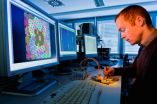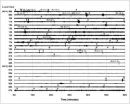(Press-News.org) Whether it's a wedding, birthday party or other celebration, these days the chances are you'll have your camcorder with you to record the great occasion. But we often forget to bring the data cable along with us, so despite promising the hosts to transfer the images to their computer the morning after, we hardly ever do. "No problem," we say, "I'll burn you a CD when I get home." It would be so much easier, though, to transfer the data wirelessly.
This thought also occurred to Frank Deicke, a researcher at the Fraunhofer Institute for Photonic Microsystems IPMS in Dresden. There just had to be a way to transfer large amounts of data quickly and easily from one device to another. Obviously, wireless connections like Bluetooth or Wi-Fi are now commonplace. But using them to copy high resolution video footage of an entire wedding reception to a computer takes a great deal of patience, as transferring several gigabytes of film data wirelessly can take several minutes. Deicke and his colleagues took a different approach. Deicke specializes in infrared technology and, a few weeks ago, the researcher presented an infrared module the like of which has never been seen before. "It transfers data at a rate of 1 gigabit per second (Gbit/s). To put this into context, one e-mail character has a size of eight bits. The infrared module is able to transfer 125 million characters per second," says Deicke.
Faster than USB2, Wi-Fi and Bluetooth
As a general rule, cable connections between electronic devices are faster than wireless ones. In this case it is the other way around. The new "multi-gigabit communication module" is six times faster than a USB2 cable. A comparison with established wireless standards is even more impressive. The IPMS solution is 46 times faster than conventional Wi-Fi and 1430 times faster than a Bluetooth connection, as used to connect cell phones and earphone headsets, for example. This performance is above all due to high-speed signal processing. In data transfer, the bottleneck is the encoding and decoding of the data, which is to say the packing and unpacking necessary to send data through the air. Before setting off, video information from the digital camera first has to be converted into a radio signal. The receiving device, a laptop for example, then decodes the radio signal and converts it back into film data. All this costs processing time.
The challenge for the researcher and his team was to build a small infrared module with fast-working hardware and software. In addition, the processing time required should be minimal, because the harder the microprocessors have to work, the more electricity they eat up. "We achieved this ultimately through a clever combination of different technical solutions," says Deicke. One of these is the transceiver, an optical component which is able to send and receive light signals simultaneously. The transceiver is only about the size of a child's fingernail, but manages to fit in a laser diode to send light pulses and a photo detector to detect them. The decoders that receive and translate the encoded data are also crucial. Deicke and his colleagues had to program ingenious error-correction mechanisms, because the light signals become weakened and distorted in the air. Just like controlling a TV with its remote, there has to be a clear line of sight between sender and receiver. This is no problem for Frank Deicke: "You simply place the camera or the smartphone next to the computer or laptop." The video is transferred in just a few seconds.
The IPMS researchers are very much aware that manufacturers have to accept such technology as standard before it can catch on. Only then will it find its way into a wide variety of devices, enabling consumers to connect almost any laptop to any camera without problems. This is why Deicke is active in the Infrared Data Association, where among other things he contributes to the "10 Giga-IR working group". This makes his goal for the future obvious: to improve on 1 Gbit per second. "Our current infrared module has already demonstrated that infrared technology is able to go far beyond established standards. We plan to improve performance even more in the future." Deicke has already been able to show that the transfer rate of his current model can be raised to 3 Gbits. 10 Gbits cannot be very far off.
INFORMATION:
Wireless data at top speed
2012-10-09
ELSE PRESS RELEASES FROM THIS DATE:
App protects Facebook users from hackers
2012-10-09
RIVERSIDE, Calif. (www.ucr.edu) — Cyber-crime is expanding to the fertile grounds of social networks and University of California, Riverside engineers are fighting it.
A recent four-month experiment conducted by several UC Riverside engineering professors and graduate students found that the application they created to detect spam and malware posts on Facebook users' walls was highly accurate, fast and efficient.
The researchers also introduced the new term "socware" to describe a combination of "social malware," encompassing all criminal and parasitic behavior on online ...
Fossil of ancient spider attack only 1 of its type ever discovered
2012-10-09
CORVALLIS, Ore. – Researchers have found what they say is the only fossil ever discovered of a spider attack on prey caught in its web – a 100 million-year-old snapshot of an engagement frozen in time.
The extraordinarily rare fossils are in a piece of amber that preserved this event in remarkable detail, an action that took place in the Hukawng Valley of Myanmar in the Early Cretaceous between 97-110 million years ago, almost certainly with dinosaurs wandering nearby.
Aside from showing the first and only fossil evidence of a spider attacking prey in its web, the piece ...
Poorer lung health leads to age-related changes in brain function
2012-10-09
COLUMBUS, Ohio – Keeping the lungs healthy could be an important way to retain thinking functions that relate to problem-solving and processing speed in one's later years, new research suggests.
While these two types of "fluid" cognitive functions were influenced by reduced pulmonary function, a drop in lung health did not appear to impair memory or lead to any significant loss of stored knowledge, the study showed.
Researchers used data from a Swedish study of aging that tracked participants' health measures for almost two decades. An analysis of the data with statistical ...
Computational model IDs potential pathways to improve plant oil production
2012-10-09
UPTON, NY - Using a computational model they designed to incorporate detailed information about plants' interconnected metabolic processes, scientists at the U.S. Department of Energy's Brookhaven National Laboratory have identified key pathways that appear to "favor" the production of either oils or proteins. The research, now published online in Plant Physiology, may point the way to new strategies to tip the balance and increase plant oil production.
The study focused on the metabolism of rapeseed, a crop grown primarily in temperate climates for the oil that accumulates ...
2010 Korea bomb 'tests' probably false alarms, says study
2012-10-09
This spring, a Swedish scientist sparked international concern with a journal article saying that radioactive particles detected in 2010 showed North Korea had set off at least two small nuclear blasts--possibly in experiments designed to boost the yields of much larger bombs. Shortly after, the pot was stirred with separate claims that some intelligence agencies suspected the detonations were done in cooperation with Iran. Now, a new paper says the tests likely never took place—or that if they did, they were too tiny to have any military significance. The new report, ...
'Wonder material' graphene could revolutionize cell phones, solar panels and more
2012-10-09
WASHINGTON, October 8, 2012 — Smart phones almost as thin and flexible as paper and virtually unbreakable. Solar panels molded to cover the surface of an electric or hybrid car. Possible treatments for damaged spinal cords. It's not science fiction. Those all are possible applications of a material known as graphene. This so-called "wonder material," the world's strongest (100 times stronger than steel) and thinnest (one ounce would cover 28 football fields), is the focus of a new episode of the ChemMatters video series. The video is at www.BytesizeScience.com.
The video, ...
A DNA-made trap may explain amyloidosis aggravation
2012-10-09
Rio de Janeiro, Brazil- Amyloidosis is a group of clinical syndromes characterized by deposits of amyloid fibrils throughout the body. These fibrils are formed by aggregates of proteins that have not been properly folded. Deposits of amyloid fibrils are found in a number of diseases, including Alzheimer's and Parkinson's diseases and type-2 diabetes. The amyloid deposits can be localized, as in the brain of Alzheimer's patients, or found spread through the body, as in amyloidosis related to mutations in the transthyretin gene.
The clinical meaning of amyloid deposits ...
Child-free women feel intense pressure to have kids -- but rarely stress over it
2012-10-09
Women who choose to be permanently childfree perceive more social pressures to become mothers than other women, but feel less distress about not having kids than women who are childless from infertility or other reasons, a new national study shows.
The study, from a national survey of nearly 1,200 American women of reproductive age with no children, identified various reasons why women have no children, from medical and situational barriers to delaying pregnancy to choosing to be childfree. It sought to determine if those reasons contributed to different types of concerns ...
Caffeine may block inflammation linked to mild cognitive impairment
2012-10-09
URBANA – Recent studies have linked caffeine consumption to a reduced risk of Alzheimer's disease, and a new University of Illinois study may be able to explain how this happens.
"We have discovered a novel signal that activates the brain-based inflammation associated with neurodegenerative diseases, and caffeine appears to block its activity. This discovery may eventually lead to drugs that could reverse or inhibit mild cognitive impairment," said Gregory Freund, a professor in the U of I's College of Medicine and a member of the U of I's Division of Nutritional Sciences.
Freund's ...
New link between high-fat 'Western' diet and atherosclerosis identified
2012-10-09
New York, NY (October 8, 2012) — Columbia University Medical Center (CUMC) researchers have found that a diet high in saturated fat raises levels of endothelial lipase (EL), an enzyme associated with the development of atherosclerosis, and, conversely, that a diet high in omega-3 polyunsaturated fat lowers levels of this enzyme. The findings establish a "new" link between diet and atherosclerosis and suggest a novel way to prevent cardiovascular heart disease. In addition, the research may help to explain why the type 2 diabetes drug rosiglitazone (Avandia) has been linked ...

